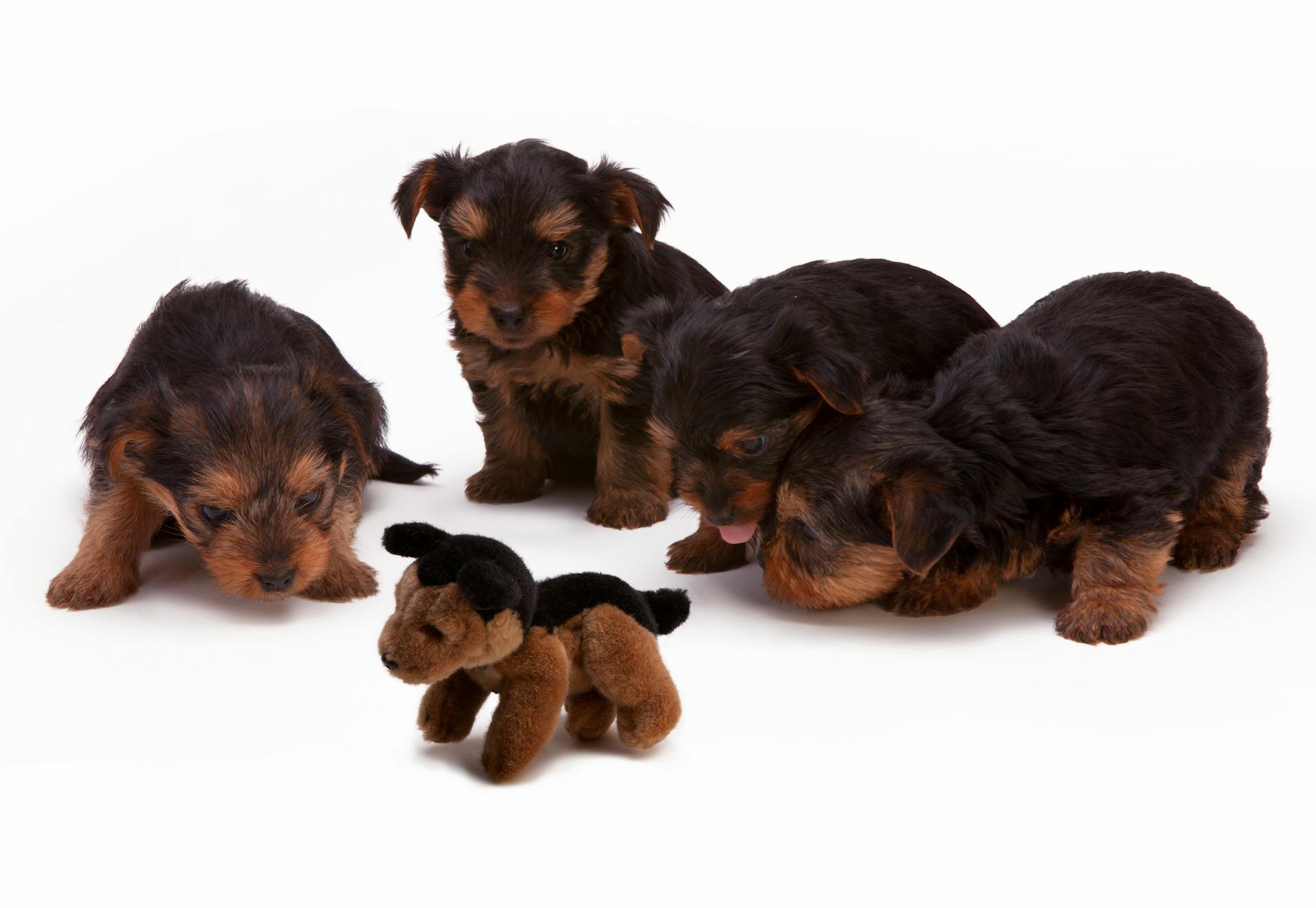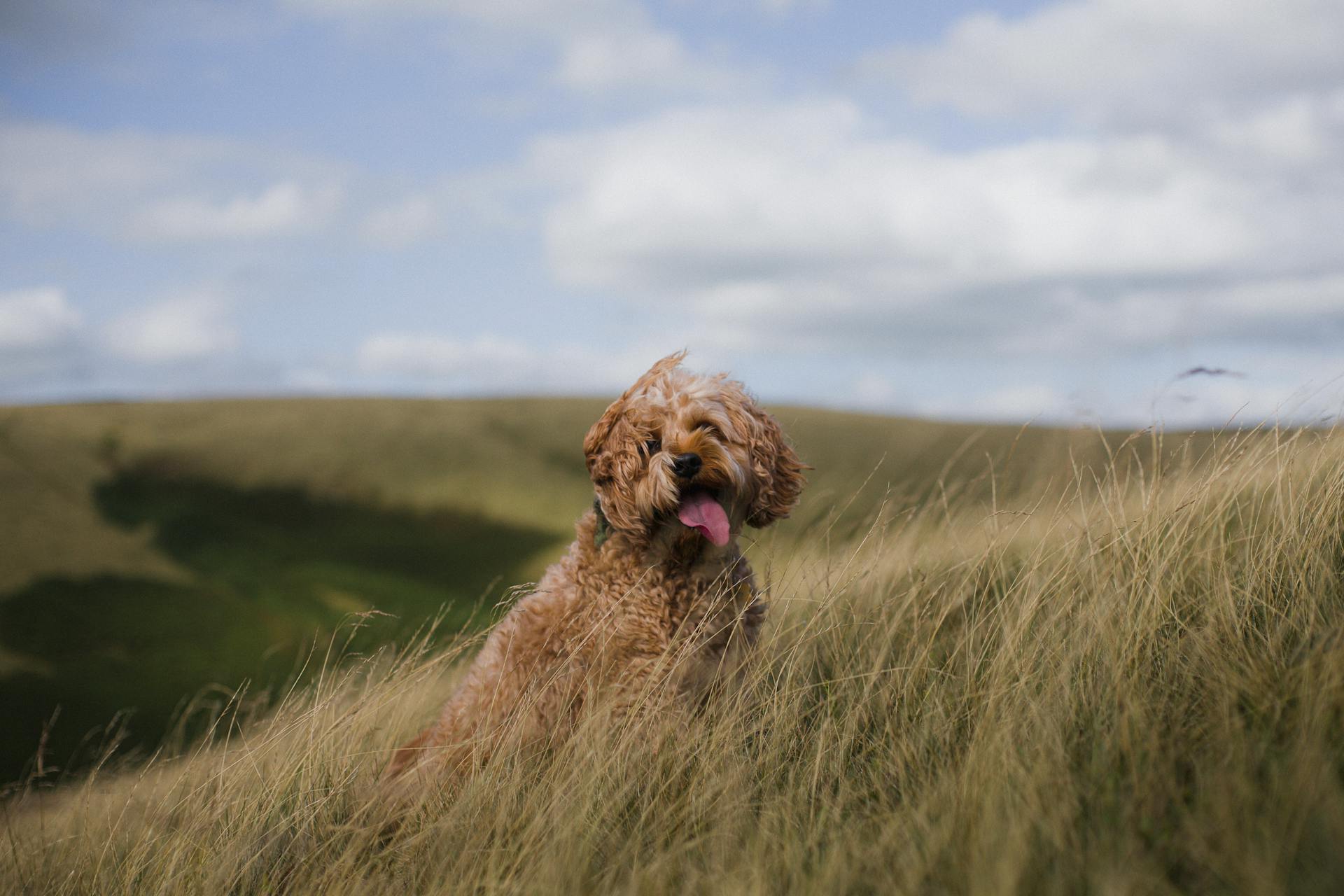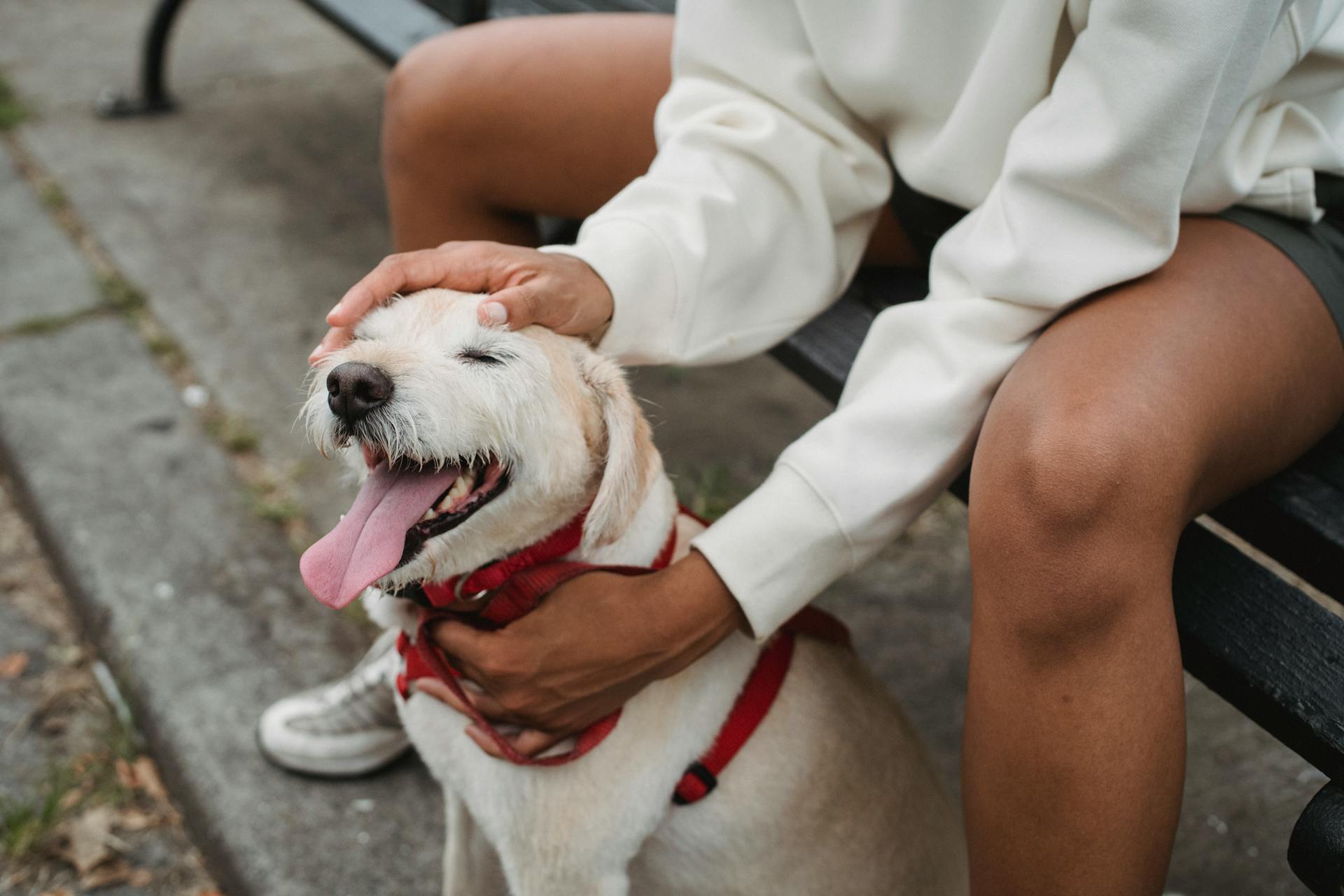
As a Maltipoo owner, you're probably wondering what to expect as your furry friend grows up. Maltipoos typically reach their full height between 9 and 12 months old.
Their adult size can vary, but on average, they weigh between 4 and 8 pounds and stand about 8 to 14 inches tall.
A healthy Maltipoo's lifespan is around 12 to 15 years, so it's essential to provide them with proper care and attention from the start.
If this caught your attention, see: 8 Week Old Maltipoo
Growth and Development
A Maltipoo's growth rate is an important aspect to monitor, especially during the first year. Your veterinarian can help identify any underlying reasons why your puppy isn't gaining weight, even if they seem healthy.
Nutritional factors play a crucial role in a Maltipoo's growth and overall health. A balanced diet rich in proteins, fats, vitamins, and minerals is essential for healthy growth.
A general rule of thumb for predicting a Maltipoo's weight gain is to take their weight at 18 weeks and double it. This will give you their expected adult weight, although it's not guaranteed.
Here's a rough estimate of the anticipated growth rates and weights of Maltipoo puppies:
Growth Phases
Maltipoos grow most rapidly in the initial months after birth, with the rate of growth tapering off as they approach adulthood. This early phase is crucial for physical and cognitive development, setting the foundation for their health and behavior as adult dogs.
Maltipoos experience distinct growth phases, each with its unique characteristics, and the amount of time it takes them to go through their growth trajectory largely depends on whether they fall into the toy, mini, or teacup size range.
Toy Maltipoos experience rapid growth during their first 6 to 8 months, quickly developing in size and personality. Mini Maltipoos have a similar rapid growth phase, but it might extend slightly longer, up to 10 months.
Teacup Maltipoos usually have the fastest growth spurt due to their small size, with their growth being notably quick within the first 5 to 6 months.
Here's a breakdown of the growth phases for each size category:
As Maltipoos grow, their energy needs increase, and they require an energy-dense and nutritious diet to support their development.
Factors Affecting Growth
Your Maltipoo's growth is influenced by several factors, including their genetics, nutrition, and overall health.
Proper nutrition is essential for a healthy growth rate. A diet that's balanced for a growing puppy ensures your Maltipoo grows at a healthy rate, with a mix of proteins, fats, vitamins, and minerals.
Genetics also play a significant role in determining your Maltipoo's growth pattern. The size category of your Maltipoo, whether toy, mini, or teacup, affects the duration of their growth phase.
Maltipoos typically reach their full size before they turn one year old, with smaller dogs growing faster than larger ones. A general rule of thumb is that the smaller the dog, the sooner they'll be fully grown.
The growth pattern of Maltipoos shows rapid growth in the first half of their puppyhood, followed by a slower growth rate as they approach adulthood. This is true for all Maltipoos, regardless of their size category.
Readers also liked: Maltipoo Growth Chart
Here's a breakdown of the growth phases of Maltipoos by size category:
Regular veterinary check-ups are crucial to monitor your Maltipoo's growth and address any potential issues early on. Even if your puppy appears healthy, your veterinarian may recommend blood tests or other diagnostic procedures to rule out underlying problems.
Origins of the
The Maltipoo's growth and development is heavily influenced by its origins as a designer breed. As a hybrid of a Maltese and a Poodle, Maltipoos can inherit traits from both parent breeds, resulting in varying sizes even within the same litter.
Their hybrid nature means that Maltipoos can fall into the mini, toy, or teacup size range. This size variation is a result of inheriting different traits from their Maltese and Poodle parents.
Since Maltipoos are not recognized by the American Kennel Club, they do not have a breed standard. This lack of standardization means that Maltipoos can exhibit a range of characteristics, from friendly and affectionate to other traits not mentioned.
Their popularity stems from their desirable traits, including being friendly and affectionate. Maltipoos thrive on human interaction and form strong bonds with their owners, making them great companions.
Health and Care
As a Maltipoo owner, you'll want to know that these dogs have a relatively long lifespan of 13-16 years, so be prepared for a long-term commitment.
Maltipoos are playful and intelligent dogs, but they don't have a high energy level, so a daily walk and some backyard play sessions should suffice to keep them happy and healthy.
A dedicated owner can help their Maltipoo remain puppy-like for their entire life with positive reinforcement training, which can teach good manners and curb unwanted behaviors.
Check this out: How Long Can a Maltipoo Be Left Alone
Pet Care
Maltipoos are playful and intelligent dogs, but they don't have the always-on-the-go mentality of some other breeds. A daily walk and some backyard play sessions can help exert some of their balled-up energy.
Maltipoos love their humans and enjoy being around them, but they also have a tendency to act like watchdogs and bark at unfamiliar sights and sounds.
Regular exercise is crucial for building strong muscles and bones in Maltipoos, but it's essential to balance physical activity with rest, especially for smaller or younger Maltipoos, to avoid overexertion.
Puppies need more sleep than adult dogs, and growth primarily occurs during rest periods. Ensuring your Maltipoo has plenty of time to rest and sleep is key for optimal growth.
Maltipoos can live for about 13-16 years, and with dedicated positive reinforcement training, they can learn good manners and remain puppy-like throughout their lives.
Coat Care
Your Maltipoo's coat can be curly like their Poodle parent, or straight and silky like their Maltese parent.
Most Maltipoos have all-white fur, but their coats can come in other colors too, including black, gray, cream, brown, and gold.
Daily brushing with a wire slicker brush is a must to prevent matting and tangling.
Regular trips to the groomer are still necessary even if you opt for a cute Maltipoo haircut like the short "puppy cut".
Will Gender Affect My Dog?
Gender can actually play a role in your dog's size, but it's not a hard and fast rule. Male puppies tend to be slightly larger than females, but this can vary greatly between litters.
It's also worth noting that a male puppy can end up smaller than his sisters, especially if his parents are smaller dogs.
The size difference between male and female puppies can be quite significant, with some litters reaching 9-13lbs and others weighing in at just 4-6lbs.
Ultimately, the size of your puppy will depend on the size of its parents, not its gender.
Intriguing read: Male Shih Tzu
Nutrition and Feeding
Nutrition and Feeding is a crucial aspect of your Maltipoo's life, especially as they grow up. A balanced diet is essential for their growth and overall health.
Puppies require a diet rich in proteins, fats, vitamins, and minerals to support their rapid development. This means feeding them high-quality dog food formulated for small breed puppies.
Maltipoo puppies typically need to eat three to four times a day, and it's best to speak with your veterinarian about the frequency and daily intake of food. They can also give you recommendations on the best food brand for your puppy.
A unique perspective: Maltipoo Puppy Food
To ensure your Maltipoo stays at a healthy weight, it's essential to monitor their caloric intake. Always measure the food you give your pet, and consult your veterinarian to learn just how much you should be feeding your dog.
Here's a rough guide to keep in mind:
Some Maltipoos may benefit from nutritional supplements, especially if your vet recommends them. These supplements can support joint health, which is essential for a happy and active life.
Nutritional Factors
A Maltipoo's nutritional needs are crucial for their growth and overall health. A balanced diet is essential for a healthy growth rate, and puppies require a diet rich in proteins, fats, vitamins, and minerals.
Proper nutrition impacts their growth in various ways, including bone and joint health. Adequate levels of calcium and phosphorus are vital for healthy bone development.
Maltipoo puppies need to eat high-quality dog food formulated for small breed puppies. They typically need to eat three to four times a day, depending on their size and intake.
For your interest: How Much Should a Maltipoo Eat a Day
Feeding your Maltipoo puppy frequently is essential to support their high energy needs and prevent hypoglycemia, especially in smaller breeds like teacup Maltipoos.
Here are some feeding guidelines to keep in mind:
- Feed your Maltipoo puppy high-quality dog food formulated for small breed puppies.
- Feed them three to four times a day, depending on their size and intake.
- Consult with your veterinarian for recommendations on the best food brand and feeding schedule for your puppy.
Nutritional Tips
A balanced diet is crucial for a Maltipoo's growth and overall health. Maltipoo puppies require a diet rich in proteins, fats, vitamins, and minerals to support their rapid development.
Proper nutrition impacts their growth in various ways, so it's essential to choose a high-quality dog food formulated for small breed puppies. These foods are designed to meet their unique nutritional needs.
Maltipoo puppies typically need to eat three to four times a day, and their food should be measured to ensure they're getting the right amount. Overfeeding can lead to obesity, so monitoring their caloric intake is crucial.
If your vet recommends nutritional supplements, Maltipoos may benefit from ones that support joint health. This is especially important for older Maltipoos or those with joint issues.
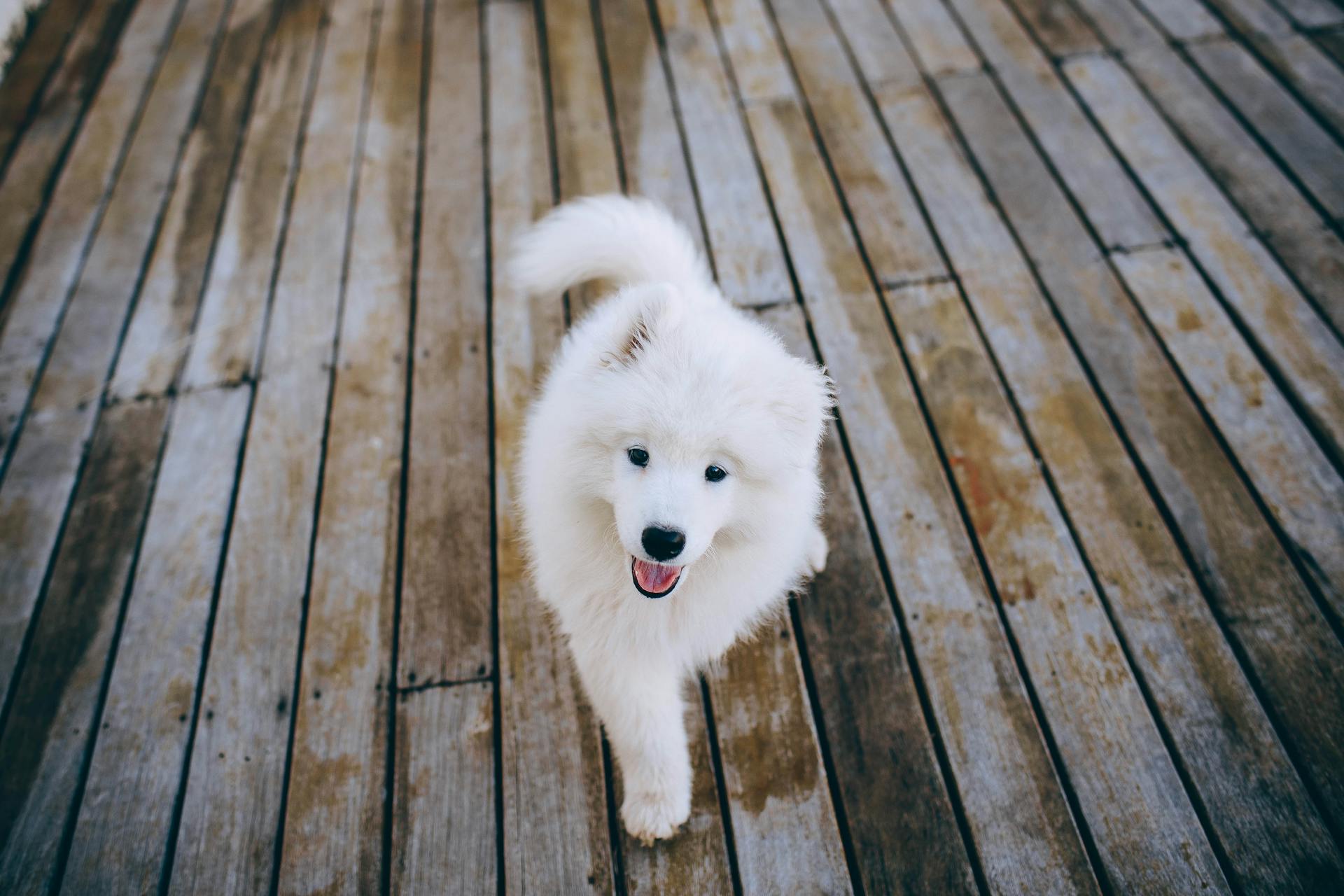
To ensure your Maltipoo is getting the nutrients they need, choose a dog food brand approved by the Association of American Feed Control Officials (AAFCO). This will help maintain their digestive system, strong teeth, and shiny coat.
Here are some key nutritional tips to keep in mind:
- Feed high-quality dog food formulated for small breed puppies.
- Measure food to ensure the right amount is being consumed.
- Monitor caloric intake to prevent obesity.
- Choose dog food brands approved by AAFCO.
Predicting Adult Size
Predicting a Maltipoo's adult size can be a fun and exciting process, but it's not an exact science. Various methods exist to estimate their grown size, but it's essential to consider the impact of genetics and health.
Doubling their weight at 4 months of age for Toy and Mini sizes, and 3 months for Teacup sizes, can provide a rough estimate. However, genetics and health factors can make this prediction less precise.
Another factor is looking at the size of the parents, especially the Poodle parent, as this can give a good indication of the potential adult size. Especially if the parents are close in size.
You might enjoy: Maltipoo Health Concerns
You can also look at past litters from the same breeding pairs to give you an idea on what to expect.
Here are some general size ranges for Maltipoos:
Keep in mind that these are just general guidelines, and the actual size of your Maltipoo may vary. It's always a good idea to consult with your veterinarian for a more accurate assessment of your dog's size and health.
General Information
A Maltipoo grown up is a wonderful companion.
Maltipoos typically weigh between 4-8 pounds and stand 8-14 inches tall. They are a small breed of dog.
Their low-shedding coat requires regular grooming to prevent matting and tangling.
Grooming Guide
Maltipoos are a high-maintenance breed that requires regular grooming to maintain their appearance.
Their grooming needs can vary depending on the unique characteristics of their coat, but they generally require more attention than other breeds.
Maltipoos don't shed as much as many other dog breeds, but they still need regular grooming to prevent matting and tangling of their fur.
A certified master groomer recommends that Maltipoos be groomed regularly to maintain their appearance, but the exact frequency may depend on the individual dog's coat type.
You might enjoy: How to Groom Maltipoo
Frequently Asked Questions
Maltipoos usually reach their adult weight and size between 9-11 months old for Toy or Tiny Maltipoos, and 11-13 months old for Miniature and Medium Maltipoos.
You can use a growth calculator or a formula to estimate your Maltipoo's full size. The formula can give you a rough estimate, but keep in mind that every dog is unique.
Maltipoos are generally considered small dogs, even the bigger ones fall in the lower end of the medium-sized breed category due to their Maltese and Poodle heritage.
Their adult size depends on genetics, parents, nutrition, and exercise levels, so make sure to provide a balanced lifestyle for your furry friend.
Readers also liked: Medium to Small Dogs Breeds
Final Thoughts
If you're a first-time Doodle parent, you're in luck because the Maltipoo community has got you covered. The Doodle Parenthood Community and Support Group is a valuable resource that's worth its $190 value, offering a safe space to ask questions and get advice from experienced owners.
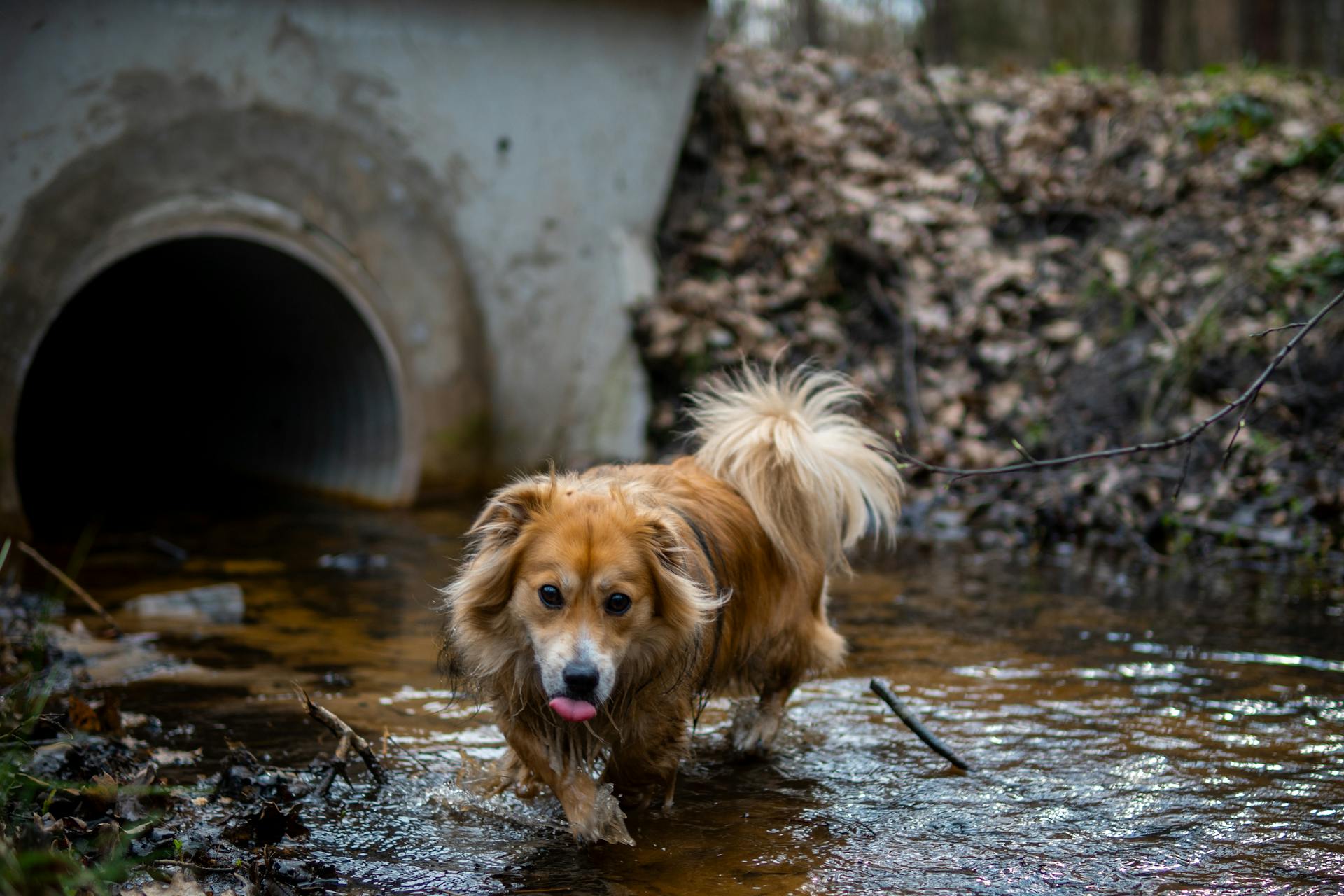
The Maltipoo's lifespan is a topic of interest for many owners. On average, a Maltipoo can live for 12-15 years, but with proper care and attention, some have been known to live up to 18 years.
Common health issues in Maltipoos include dental problems, patellar luxation, and eye issues. These can be prevented or managed with regular veterinary check-ups and a healthy lifestyle.
The Maltipoo Growth Tracker is a useful tool that helps you monitor your puppy's growth and development. This $20 value is a small price to pay for the peace of mind that comes with knowing your puppy is on track.
In case of an emergency, the EMERGENCY Cheatsheet: When To Call The Vet Immediately is a must-have resource. This $50 value is a small price to pay for the reassurance that comes with knowing what to do in a crisis.
A Maltipoo's health can be unpredictable, but with the right tools and support, you can navigate any challenges that come your way.
You might enjoy: Maltipoo Prices
Frequently Asked Questions
Do Maltipoo bark a lot?
Maltipoos are generally quiet dogs, but may bark occasionally to alert their owners to strangers or danger. They tend to be less excessive barkers compared to their energetic Maltese counterparts.
Is a Maltipoo a good dog?
A Maltipoo can make a wonderful companion for many families, but like any dog, they require proper socialization and attention to thrive. With the right care, Maltipoos can bring joy and affection to your life.
Do Maltipoos get curlier as they get older?
Yes, Maltipoos' coats tend to become curlier as they mature, typically around 6-8 months of age. Regular brushing can help prevent matting and knots in their adult coat.
What are the behavioral issues of a Maltipoo?
Maltipoos may exhibit behavioral issues such as disobedience and lack of respect for household rules. This can manifest as ignoring commands and having unrestricted access to the home.
Featured Images: pexels.com
